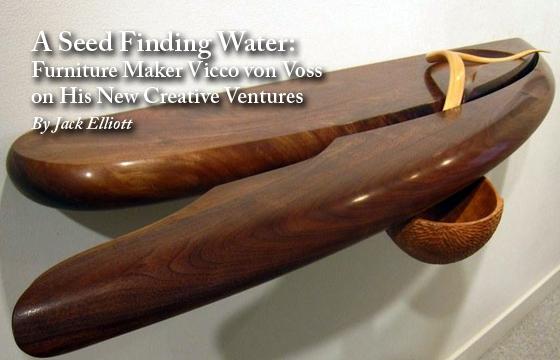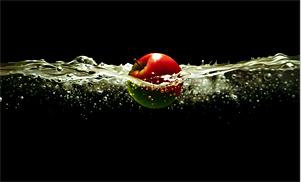“There’s this guy,” Vicco tells me, hands gesturing openly. “He goes scaling up a crevasse, in this movie called 127 Hours. He says to the people he is with, ‘okay, now let go.’ And he goes like this” – Vicco folds his arms across his chest and lifts his legs from the ground, leaning back into the sofa – “and he freefalls into a lake that’s way underground, formed by this crevasse. It’s that mystery of trusting but also of the unknown within that crevasse. What is it that we can find down there? I guess that’s symbolic of [‘Finding Water’]. What can I find within this piece of wood that’s exploratory?”
I’m sitting with furniture maker Vicco von Voss in the sun-flooded loft office of his Bolz Shop. He just explained to me the influence that the movie 127 Hours had on “Finding Water,” one of his pieces currently on display at the Massoni Gallery in Chestertown. By way of metaphor, Vicco has also explained the whole idea of the Seed Project through his description of this piece of sculptural furniture.
“The Academy Art Museum in Easton called me and asked if I wanted to do a show in 2014, which is a high honor,” Vicco tells me. “The problem is that I don’t have a body of work to show, and you can’t just go to clients and say, ‘I need to borrow your table for two months.’”
The Seed Project grew out of Carla Massoni’s initial enthusiasm about Vicco’s new undertaking to create a body of museum-quality pieces. Carla Massoni owns the Massoni Gallery in downtown Chestertown, where Vicco has displayed his work for years. She offered to help sponsor Vicco, and the two of them together began to brainstorm about what it means to be a sponsor.
Vicco realized that he needed to be able to produce work outside of the restraining guidelines of commission work, while still being able to feed himself and his family – ever the plight of the artist.
With quite a bit of excitement in her eyes, Massoni describes her dream of having the Seed Project participants act “like the Medici.” The Medici family nursed the Renaissance into being by acting as patrons to the artists of its day. Massoni hopes that a similar engagement with the arts can exist on a smaller scale in today’s world of ever-shrinking art-department budgets. She describes the Seed Project as “30% venture capitalism, 30% romanticism, and 30% whatever else.”
Patrons can contribute to the project, starting at $1000. When the pieces created for the exhibition finish the tour and sell, the patrons get their money back.
Vicco stresses that “it’s not about the money; it’s about building momentum. The idea is to get as many people involved as possible, so that there is a momentum of excitement within the whole process of building these pieces. When one piece finishes, we’ll have a photo shoot here; we’ll have people come, have a little cocktail party; they’ll get to see the piece, and they’ll have first right of refusal at that point to purchase the piece, which is a major thing for this momentum. It’s not free money. I have an obligation to pay this money back, and I intend to do that by creating invaluable pieces.”
As Vicco moves from explaining the logistics of the project to describing the creative potential it unlocks, he becomes increasingly expressive, and he reveals his true excitement about the project: the chance to create above and beyond any planned work.
“When you do a commission, and don’t get me wrong, commissions are wonderful, but it’s really in the design process that I create the piece. And it’s in collaboration with the client, which I enjoy. But, after the piece has been designed I am fixed in a way to build the piece to meet certain specifications. Versus, in the Seed Project, I might have a concept of what I want to do, but the piece evolves as I am building it, and then something may happen where I’m challenging myself beyond my comfort zone, where I’m just exploring the medium.”
The Seed Project grows from the same thinking that inspired the “Midstream” exhibition that is currently on display at the Massoni gallery. The artists in this show are, like Vicco, full-time artists who have mastered their respective media and are at the point of greater experimentation when they can find out how far artistically they can push their honed skills.
“I’ve mastered all of my skills,” Vicco tells me. “I’ve mastered milling; I’ve mastered timber-framing; I’ve mastered my wood-working. So, now how can I take all of these three aspects and implement them in the seed project and produce work that’s beyond my comfort zone, my box. In my box, I’m comfortable. I want to be able to look outside of my box and push that, and the only way you can do that is if you’re exploring.”
Vicco’s explanation of the “sprout” on “Finding Water” is virtually a narration of his own personal quest to find the unknown wells of his creative expression.
“I went to the beach with my daughter Ella,” Vicco tells me, explaining how his observations of the natural world found their way into “Finding Water.” “And there was a little pond there and I was studying it, because Greg Mort did that piece with the apple. I was really intrigued with what water does when it splashes around; so when I was at the beach I was looking at what the water had done as it washed away the sand, and how it was sculpted. Then I tried to translate that into this wood. There’s a little pond and then a wash away that goes down into the crevasse again. So my original idea for the first piece for the Seed Project was to carve a little seed and have the seed sprout go down, looking for the crevasse, or looking for water. But that was too literal. That was within my comfort zone. So I was thinking about it and there needed to be more of a mystery about it. The mystery came. Then I said, ‘what if this seed is in the ground, in the unknown, and you don’t know what’s happening, but the seed is germinating, and as it germinates that first sprout that comes out, that’s finding water; it’s looking for water.’”
“Making that little sprout, rather than cutting it out of a solid piece of wood, which would have been really fragile, I ended up using veneers that are then bent in a compound curve, making it incredibly strong, exploring ‘what can I do in this wood medium? And what are my capabilities and what are my limits?’ It’s like, ‘Oh, wow!’ What ended up happening is that, where the laminations were, it ended up looking like wood grain, so a lot of unexpected things happened plus the thing is very strong. So you can lift it out if you want to wipe the shelf and then put it back.”
“The big challenge was, ‘what do I do with the seed?’ So, playing around with that I wondered if I should have just suggested that it’s a seed, but then I felt that you would lose the sense of what it is, and I think it’s important for people to be able to identify what it is, you know, a seed, so I looked at an acorn and I basically carved half of an acorn, forming the husk which then has that texture on it, going into the smooth, and the surprise that then becomes a drawer. It’s not just a seed hanging underneath. It’s functional. It’s also got a surprise. Whenever I open it, people are like ” – Vicco inhales sharply – “You can hear them. There’s an awe factor, ‘wow, that’s really cool!’ So it’s really the seed germinating, trying to find water, and it’s that elegance that becomes sculpture as well as a functional shelf.”
“Now that I’ve done that, now that I’ve explored outside of the box, maybe I can use that bent lamination for other forms. I can say, ‘okay, now how can I use this on a bigger scale?’”
Vicco is undaunted when I ask him whether the responsibility of paying back the seed money restricts his artistic exploration due to the fact that the pieces need to be sold.
“It is a little bit of a constraint that I’m responsible for paying the money back. But, I’m really hoping that within this time period I’m going to develop pieces that are going to be so awesome that people will get as excited as I am and want to buy them. I feel so alive right now in my work. I just want to start producing.”
Vicco is asking the supporters of the Seed Project to leap into the crevasse with him, but he is confident that there’s a cool lake at the bottom, and so, apparently, is the Academy Art Museum.
Contact Carla Massoni at [email protected] for more information about the Seed Project, or contact Vicco at [email protected].
By Jack Elliott
..







